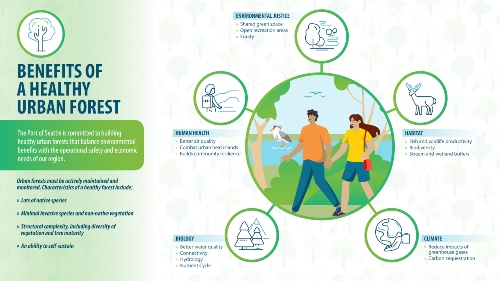
The Port of Seattle Commission today adopted principles to guide the development of the Port’s environmental land stewardship efforts for trees, forests, and other habitat. The Order builds on the Port’s existing regional and industry leadership on these topics with new principles and strategies for land stewardship across all Port facilities and properties.
“Port staff are already undertaking impressive land stewardship practices on Port properties, from organic landscaping at our parks to removing invasive species and planting trees in urban forests,” said Port of Seattle Commission Vice President Toshiko Hasegawa. “This order institutionalizes Division-specific practices into Port-wide policy. The order also provides direction for future decision-making and ensures that environmental land stewardship activities will include an equity lens.”
This Order enhances community engagement and stewardship efforts that the Port has implemented previously through its Airport Community Ecology Fund, currently through the South King County Community Impact Fund Environmental Grants program and through the Green Cities Partnership, which funded development of Urban Forest Management Plans in partnership with the cities around Seattle-Tacoma International Airport (SEA).
Additionally, through the first two phases of the Port's Flight Corridor Safety Program (FCSP), the Port, Washington State Department of Transportation (WSDOT), and the City of SeaTac have planted, or will plant, approximately 12,148 new trees to replace the 978 trees that were required to be removed on properties near the airport. The FCSP helps the Port maintain required aviation safety standards while expanding the number of native trees planted in areas around SEA Airport that do not impact flight safety.
Land Stewardship Principles
The Port Commission Order recognizes that trees, forests, and other habitat provide valuable benefits to the environment and regional quality of life, including addressing environmental justice, improving environmental health, increasing climate resilience, and improving habitat quality and biological productivity. The Order adopts five main principles:
- Use a comprehensive approach to environmental land stewardship, including trees, forests, and other habitat.
- Maximize opportunities to increase trees, forest, and other habitat as part of infrastructure planning and design.
- Apply an equity and environmental justice lens to environmental land stewardship.
- Support community partnerships and leverage inter-governmental coordination and Port funds to catalyze stewardship processes and outcomes.
- Use a holistic approach to stewardship to ensure trees, forest, and other habitat are healthy and self-sustaining.
The order also identifies four land stewardship strategies to advance the principles in support of the Port’s robust existing environmental programs and practices:
- Develop an Aviation (SEA) Land Stewardship Plan by Q4 2023 to create land stewardship goals to prioritize actions that integrate and balance environmental land stewardship with airport operations, planning, and development.
- Adopt Aviation (SEA) Tree Replacement Standards that meet or go beyond the minimum regulatory requirements of our neighboring jurisdictions. The standards must also ensure continued compliance with city, state, and federal development standards for all operations and development activities as well as ensure that development and other land use impacts replace cleared trees and forest. Finally, the Order directs Port staff to identify opportunities for additional types of beneficial habitat such as pollinator meadows and wetlands.
- Integrate trees, forest, and other habitat stewardship into existing Maritime programs. Port Maritime staff will continue to implement the Sustainable Shorelines Program and the Multi-site Mitigation Banking Program to create additional trees, forest, and other habitat; continue to enhance and increase trees, forest, and other habitat through maintenance at existing restoration sites and parks; and continue to seek innovative ways to support restoration of kelp forests and eelgrass beds in collaboration with statewide recovery efforts.
- Update the Sustainable Evaluation Framework. For Port capital projects subject to the Sustainable Evaluation Framework — which ensures environmental and sustainability planning in the initial design phases of large infrastructure investments — the Order incorporates consideration of environmental land stewardship into the evaluation framework, including documenting trees, forest, and other habitat as part of project evaluations.
To learn more, visit the Environment and Sustainability page and sign up for the quarterly Evergreen newsletter.

Contact
Chris Guizlo | Aviation Communications & Marketing
(206) 787-3433 | [email protected]




